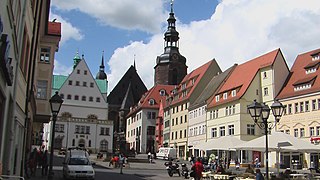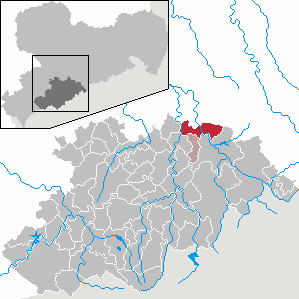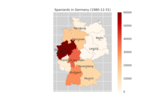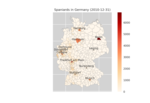
Merseburg is a town in central Germany in southern Saxony-Anhalt, situated on the river Saale, and approximately 14 km south of Halle (Saale) and 30 km west of Leipzig. It is the capital of the Saalekreis district. It had a diocese founded by Archbishop Adalbert of Magdeburg. The University of Merseburg is located within the town. Merseburg has around 35,000 inhabitants.

Schönebeck, officially Schönebeck (Elbe), is a town in the district of Salzlandkreis, in Saxony-Anhalt, Germany. It is situated on the left bank of the Elbe, approx. 14 kilometres southeast of Magdeburg.

Eisleben is a town in Saxony-Anhalt, Germany. It is famous as both the hometown of the influential theologian Martin Luther and the place where he died; hence, its official name is Lutherstadt Eisleben.

Weißenfels is the largest town of the Burgenlandkreis district, in southern Saxony-Anhalt, central Germany. It is situated on the river Saale, approximately 30 km (20 mi) south of Halle.

Oschersleben is a town in the Börde district, in Saxony-Anhalt, Germany. The population in 1905 was 13,271, in 2020 about 19,000.

Saara is a village and a former municipality in the district of Altenburger Land, Thuringia, Germany.

Genthin is a town in Jerichower Land district, in Saxony-Anhalt, Germany.

Möckern is a town in the Jerichower Land district, in Saxony-Anhalt, Germany. It is situated east of Magdeburg. The Battle of Möckern took place south of the town in 1813.

Hohe Börde was a Verwaltungsgemeinschaft in the Börde district, in Saxony-Anhalt, Germany. It was situated west of Magdeburg. The seat of the Verwaltungsgemeinschaft was in Irxleben. It was disbanded on 1 January 2010.

The Federal Statistical Office is a federal authority of Germany. It reports to the Federal Ministry of the Interior.

The Greeks in Germany comprise German residents or citizens of Greek heritage and Greeks who immigrated to Germany. According to the Federal Statistical Office of Germany, 453,000 people living in Germany in 2019 had full or partial Greek ancestry. 363,650 of these were Greek citizens.

Grünhainichen is a municipality in the district Erzgebirgskreis, in Saxony, Germany. On 1 March 2009, Grünhainichen and the neighboring municipality Waldkirchen were merged. On 1 January 2015, the former municipality Borstendorf became part of Grünhainichen.

Weischlitz is a municipality in the Vogtlandkreis district, in Saxony, Germany. It absorbed the former municipalities Kloschwitz and Kürbitz in 1999, Burgstein in 2011, and Reuth in 2017.
Straguth is a village and a former municipality in the district of Anhalt-Bitterfeld, in Saxony-Anhalt, Germany. Since 1 January 2010, it is part of the town Zerbst.
Rosian is a village and a former municipality in the Jerichower Land district, in Saxony-Anhalt, Germany. Since 1 January 2009, it is part of the town Möckern.

Teutschenthal is a municipality in the Saalekreis district, Saxony-Anhalt, Germany. In January 2005 it absorbed the former municipalities Holleben and Zscherben, in January 2010 Dornstedt, Langenbogen and Steuden and in September 2010 Angersdorf.

Serbs in Germany refers to persons living in Germany who have total or partial Serbian ancestry. They form the seventh largest group of foreigners in Germany.

Germany–Niger relations focus primarily on cooperation in development, security, and migration policy. Since 2016, bilateral relations have been significantly intensified, with several state visits at the highest level.































